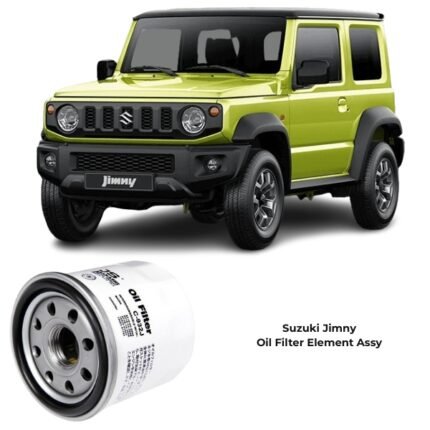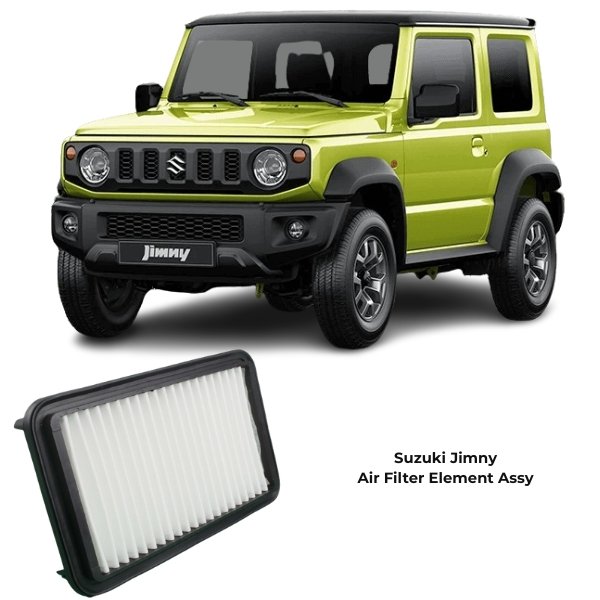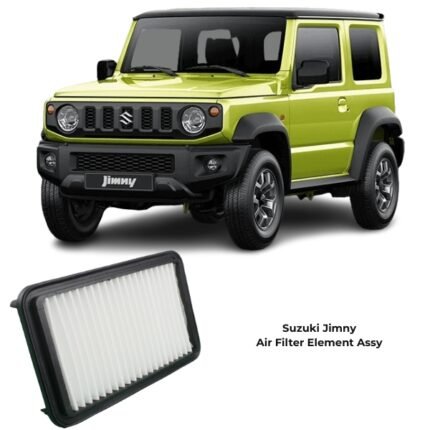Get Suzuki Jimny Air Filter Element Assy A963J in Kenya
The Air Filter Element Assembly is one of the most essential components in an internal combustion engine’s air intake system. It plays a crucial role in ensuring that only clean, dust-free air enters the engine for combustion. Although it may appear to be a simple part, its impact on engine performance, fuel efficiency, and longevity is immense. A well-functioning air filter assembly protects the engine from harmful particles, ensuring optimal airflow and maintaining precise air-to-fuel ratios necessary for efficient combustion.
1. Purpose and Function
The main function of the air filter element assembly is to clean the air that enters the engine. The combustion process requires a balanced mixture of air and fuel — typically around 14.7 parts air to 1 part fuel. However, the air outside contains impurities like dust, pollen, sand, soot, and other fine particles. If these contaminants enter the combustion chamber, they can cause abrasive wear on the engine’s internal parts, including the cylinder walls, pistons, and valves.
The air filter element assembly traps these harmful particles before they reach the engine. It ensures only filtered, oxygen-rich air flows into the intake manifold, thereby maintaining efficient combustion, reducing emissions, and extending engine life.
2. Components of the Air Filter Assembly
The air filter element assembly is typically made up of several key components that work together to ensure efficient filtration and proper airflow:
-
Filter Element – The core of the assembly, made of pleated paper, cotton gauze, or synthetic fibers. The pleated design increases surface area, allowing better air passage and longer service intervals.
-
Filter Housing – The protective casing that encloses the filter element. It is designed to fit securely within the air intake system and prevent unfiltered air from bypassing the element.
-
Sealing Gasket – Ensures a tight seal between the housing and the filter element, preventing any air leakage.
-
Air Inlet and Outlet Ports – Designed for controlled airflow into and out of the filter assembly to maintain consistent pressure and flow rate.
-
Support Frame or Mesh – Reinforces the filter media, preventing collapse or deformation under high airflow conditions.
3. Types of Air Filter Elements
Different vehicles and engines use specific types of air filters based on design and operating conditions. The common types include:
-
Paper Air Filters – Made of pleated cellulose fibers, these are the most widely used due to their cost-effectiveness and good filtration efficiency. They are disposable and replaced at regular service intervals.
-
Foam Air Filters – Constructed from polyurethane foam, often used in off-road or heavy-duty vehicles where dust exposure is extreme. They can be cleaned and reused multiple times.
-
Cotton Gauze Filters – High-performance filters made from layers of oiled cotton. They allow excellent airflow and can be washed and reused, commonly found in sports or racing vehicles.
-
Synthetic Fiber Filters – Made from advanced synthetic materials that provide high filtration capacity, long life, and consistent performance even in dusty conditions.
4. Working Principle
As the engine runs, air is drawn through the intake system. The air passes through the air filter element where filtration occurs in multiple stages:
-
Surface Filtration – Large particles are trapped on the outer surface of the filter media.
-
Depth Filtration – Smaller particles penetrate deeper into the filter layers and are captured within the fibers.
-
Clean Air Outlet – Once the air is purified, it exits through the clean side of the assembly and flows into the engine’s intake manifold for combustion.
This multi-stage filtration process ensures that only clean air reaches the combustion chamber, preventing dust and debris from damaging sensitive engine parts.
5. Importance in Engine Performance
The air filter element directly influences several critical aspects of engine performance:
-
Fuel Efficiency: A clean filter ensures the correct air-fuel mixture. When the air filter becomes clogged, airflow decreases, causing the engine to consume more fuel to compensate for the lack of oxygen.
-
Engine Power: Adequate airflow allows proper combustion, improving throttle response and engine output.
-
Emission Control: Clean air filters contribute to complete combustion, reducing the amount of unburned fuel and harmful exhaust emissions.
-
Engine Protection: By preventing dirt and contaminants from entering the combustion chamber, the air filter protects internal engine components from premature wear and damage.
6. Signs of a Dirty or Faulty Air Filter
Over time, air filters accumulate dust and debris, reducing airflow and performance. Common signs indicating it’s time to replace the air filter include:
-
Decreased fuel economy
-
Reduced engine power and acceleration
-
Rough idling or misfiring
-
Unusual engine noises or suction sounds
-
Dark or sooty exhaust smoke
-
A visibly dirty or clogged filter element
If these symptoms appear, the air filter should be inspected and replaced immediately to avoid long-term engine damage.
7. Maintenance and Replacement
Regular maintenance of the air filter assembly is vital to keeping your engine in top condition. The recommended replacement interval varies depending on driving conditions:
-
Urban/Highway Driving: Replace every 10,000–15,000 kilometers.
-
Dusty or Off-Road Conditions: Replace every 5,000–8,000 kilometers or as needed.
During maintenance:
-
Remove the air filter housing cover carefully.
-
Take out the old filter element.
-
Clean the housing to remove trapped debris.
-
Install a new or cleaned filter, ensuring proper sealing.
-
Refit the cover securely to avoid air leaks.
Proper installation ensures maximum protection and performance.
8. Material and Design Innovations
Modern air filter assemblies incorporate advanced materials and technologies to enhance durability and filtration efficiency. Some use nanofiber coatings that trap microscopic particles while maintaining optimal airflow. Others feature multi-layer synthetic media that resist moisture and oil contamination. The housing design is often optimized through computational fluid dynamics (CFD) to ensure smooth airflow and reduced turbulence.
Additionally, eco-friendly filters made from recyclable materials are becoming popular, minimizing environmental impact after disposal.
9. Consequences of Neglecting Air Filter Maintenance
Neglecting air filter maintenance can have serious consequences for an engine’s health and performance:
-
Engine Wear: Dust and sand particles can scratch cylinder walls, pistons, and valves.
-
Poor Fuel Economy: The engine burns more fuel to compensate for reduced oxygen.
-
Reduced Power: Insufficient air supply limits combustion efficiency.
-
Increased Emissions: Dirty filters lead to incomplete combustion, increasing carbon buildup and harmful exhaust gases.
-
Sensor Damage: Contaminated air can foul sensors like the Mass Air Flow (MAF) sensor, leading to inaccurate readings and poor engine management.
Routine inspection and timely replacement prevent these costly issues.
Follow us on Facebook for more parts.





Reviews
Clear filtersThere are no reviews yet.